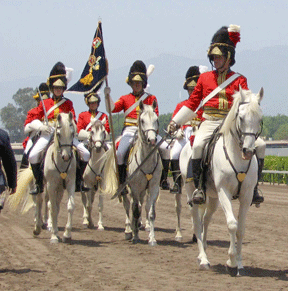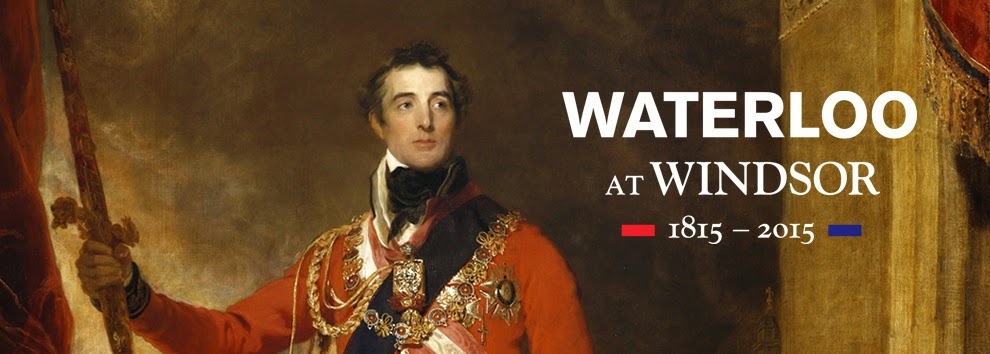From Adventures In Historyland
Waterloo being what it is, all you hear about in terms of British allies, is the Prussians, the Belgians and the Dutch. It may of interest to you good readers, to hear about the Italian connection and the story of a little known Waterloo Man.
To begin with there is the Corsican. As British contemporary caricaturists loved to point out, Napoleon was French by adoption rather than birth. To me this still makes him more French than Italian but on a purely factual level they were correct. Napoleon was not the only Corsican on the field however, on the other side of the shallow valley of Mont St Jean was Count Pozzo di Borgo, Russian diplomat and Military observer for the Tsar, attending on Louis XVIII at Ghent, who suffered a contusion while riding with Wellington’s staff at Waterloo. The Duke asked him to write the letter to Louis confirming Napoleon’s defeat that evening.
Paolo Francisco, Count De Sales, was doing a similar job to di Borgo. He was born in Savoy but he owed his allegiance to the King of Piedmont Sardinia and he is remembered as one of the men who organised the Sardinian Army. He was one of the last men on the Duke’s overstretched and badly reduced staff, still available at the end of the day.

One of the most interesting is a young lieutenant of about 24, that Reese Gronow saw riding along the position with Wellington’s staff before the battle started. His name was Count Paolo Ruffo and he was the second son of the Neapolitan Ambassador to London, Fabrizio, Prince of Castelcicala. Paolo was born in Richmond in 1791 and educated at Eton and he left school in 1811 to join the British army. His father moved in elevated circles and arranging a commission for his son would not have been an obstacle. Paolo joined the 6th (Inneskilling) Heavy Dragoons and on the 3rd of May 1815 advanced to the rank of Lieutenant. A young man who would one day become a prince could be expected to be quite popular amongst fellow officers, he appears to have been fairly well known through the army in Belgium, and it is intimated that he had friends enough to gain invitation to ride on the General Staff, (Perhaps as an orderly). Wellington preferred to populate his “Military family” with bright young things from good backgrounds and Paolo certainly qualified as both.
Young Ruffo’s actions during the momentous day are rather vague, though he is supposed to have garnered praise for his gallantry. Gronow saw him on the staff and he is further supposed to have “Galloped” for Wellington at least twice during the day, which rather discounts him from being with his regiment during their famous charge against D’Erlon’s Corps. Nevertheless though line officers might deride staffers for their perks and cushy appointments, in action, staff officers had one of the most dangerous jobs in the army and Wellington’s were usually with him were the fighting was thickest. Sometime after his second assignment Ruffo received a wound, I have not confirmed where he was hit, but it took him out of the battle. Indeed the inference may be that he was left on the field overnight and rescued as he is listed as “Missing”. Even if he was not lost amongst the piles of corpses, his wound was serious, a fact testified to by Dr. Samuel Cooper and the fact it took him about a year to fully recover. When news of the battle reached his mother, Giustina, she became very concerned for his safety as word came that he was missing, and then that he had been wounded, which would give her cause to thank God for small mercies.
Ruffo’s singular status as heir to a distinguished title and son of a diplomatic official singled him out for help in his recovery. In 1816 the Prince Regent instructed Horse Guards to grant him a year’s pay, (£164 5s), and had his medical bills paid for. His presence at the Battle made him eligible to receive the Waterloo Medal, which was placed on his coffin at his funeral, and in 1817 he resumed his military duties, making a transfer to a more senior (and prestigious) regiment, the 4th Dragoon Guards. He served in Ireland, participating in a courts martial as Dept. Judge Advocate General, and served honourably until 1821 when he retired for health and family considerations. Though he was second son (Edward had been a Cornet in the 2nd, Queen’s, Regiment of Dragoon Guards but died in 1821) he went on to inherit his father’s title after he died of Cholera in 1832 and to serve 3 Kings of Naples, as a diplomat, (Much like the Count de Sales and di Borgo did after the war) to Russia, Britain and Austria between 1831 and 52, and became “Luogotenente generale dei reali domini al di là del Faro” of Sicily in 1855.
 |
Paolo Ruffo di Bagnaria, Prince o
f Castelcicala by William Salter 1834-40.
National Portrait Gallery.
While serving in his father’s old position as Neapolitan ambassador, smoothing out a rather unctuous diplomatic ruffle between Naples and London, he reacquainted himself with the Duke of Wellington who greeted him as an old friend, gaining invitations to dine with him.
Despite his energy and readiness to serve he required a personal letter from the King to get him to Palermo to take the post as Viceroy, were he was faced with calming tensions that had arisen from his predecessor’s heavy handiness. He had married married the daughter of the Swiss ambassador to Paris, Madmoiselle Taddea Wilhelmina de Zeltner in 1832, and they had a daughter, Giustina Ruffo in 1839, when Wilhelmina died in 1855 he had sank into a deep depression, but he felt it his duty to obey the King.
Though a firm but conciliatory policy and his efforts to modify and modernise to make better living conditions, which included putting lights in the port cities of Sicily, building a new port at Milazzo, and decreasing taxes, he became very popular. In 1857 Commissioners reported the kingdom in a perfect state, and in 1859 he was elevated to the order of St Ferdinand. He served as chief of Staff to the Bourbon army when Garibaldi invaded Sicily, the subsequent debacle prompted the Prince to tender his resignation which was accepted, and he returned to Naples where the title of Counsellor of State was conferred on him. In 1865 he was sent to Rome to await further orders which never came due to the fall of Gatae, and he went to Paris where he stayed until his death in 1865.
While in London, between 1841 and 1852, he was a regular at the later Waterloo Banquets, where he was a welcome addition to the ever dwindling pool of officer’s that had been present at the battle. He was a guest at the very last dinner at Apsley House in 1852, where he sat on his host’s right. At the meal the Duke rose to falteringly gave his health.
“I will give you, the health of an illustrious foreigner whom I had the honour of having under my command at Waterloo, Prince, Prince ” here, unsure as how to pronounce the title he stopped, and though all knew who he meant none had the courage to prompt him. At last Lord Sandys, who, has been Lord Arthur Hill, at Waterloo called out, “The Field-Marshal gives the health of Prince Castelcicala.”
“Exactly so,” said the Duke, “That’s the name. Prince Castelcicala.”
I found out about the good Prince by accident, as I did the other Italians I mentioned, I hope you enjoyed reading about this Waterloo Man as much as I did writing about him.
Sources:
The Sydney Morning Herald (NSW : 1842 – 1954) Friday 19 Oct 1849
The Tablet, 13, 24th June 1848.
The Illustrated London News, Volume 1.
History of the French Revolution and of the Wars… By Christopher Kelly
The Battle, By Alessandro Barbero
Fifty years of my life, George Thomas Kepple.
The Spectator, 22 JUNE 1850,
Le Prince de Castelcicala, 1866.
|
Many thanks again to Josh at
Adventures in Historyland for allowing us to reprint this fabulous article.
Contact Josh via email – adventuresinhistoryland@gmail.com
Or follow him on Twitter @LandOfHistory
FROM THE BRITISH WEEKLY –
THIS YEAR marks the 200th anniversary of the Battle of Waterloo, the epic climax to the Napoleonic war on Belgian soil that finally banished the spectre of French domination of the Continent and enshrined The Duke of Wellington’s place in history. Waterloo also ushered in a period of relative peace and prosperity among the major European nations that was not completely broken until the outbreak of World War One almost a century later.
Not surprisingly there are countless events planned to mark the anniversary of this pivotal battle during the week of June 15-22nd. But one group with a local connection hoping to participate is the charity Greys & Glory, which is composed of active and former members of the Royal Scots Dragoon Guards and civilian members of the War Horse Foundation from Los Angeles.

The War Horse Foundation has been presenting the 1815 Royal Scots Greys since 2002 at events including the Tournament of Roses Parade and numerous Scottish festivals
The organizers of the charity hope to recreate the troupe of the Royal Scots Greys, a cavalry brigade sadly now defunct but whose name will be forever linked with many of the most famous chapters in British military history. The troupe was finally disbanded in 1971 after an illustrious history spanning almost three hundred years. It was the Greys who led a pivotal cavalry charge in support of the infantry during Waterloo and captured the French eagle standard from the formidable French 45th infantry division. An act immortalized in Lady Elizabeth Butler’s famous painting of the event.
The War Horse Foundation has been presenting the 1815 Royal Scots Greys since 2002 at numerous events, Scottish Festivals and the Tournament of Roses Parade. And this summer the Greys and Glory troupe will be at Waterloo presenting to an anticipated 300,000 spectators and countless millions more watching around the world. During the ceremonies they plan to hold a separate event for the veterans and active service and public to attend, commemorating the Scots Greys by reading the names of the fallen riders.
But the organization need to equip, refit, manufacture uniforms, gear and accoutrements for rider and horse. They also have to procure proper grey horses, suitable for presentation and the stimulus of guns and cannon fire. Getting the horses to Waterlool and maintaining their care is the biggest expense. They need help and donations. They are launching a crowfunding venture this month and will hold several fundraising events during the spring. To see how you can help, visit
greysandglory.org or
warhorsefoundation.com. They can also be found on Facebook and can be reached at: 818 694-9277.
Fritz Bronner, the Director of the War Horse & Militaria Heritage Foundation told the British Weekly this week: “As an American, (with Scottish, English and Welsh heritage)…. it is a great opportunity for all Americans to recognize the heritage of the Greys as well as say thank you to the current British Regiment and say “thank-you” to our closest, ally and friends; Great Britain. For the many British and Scottish ex-pats , it is a chance to share their heritage and patriotism to remember and commemorate British Soldiers past and present.”












